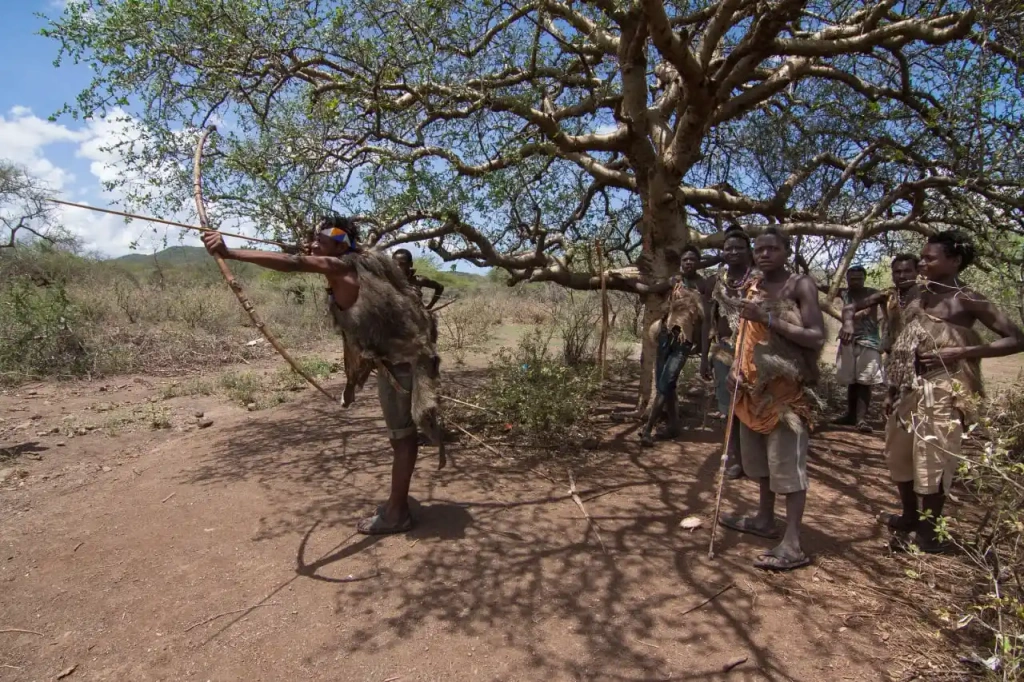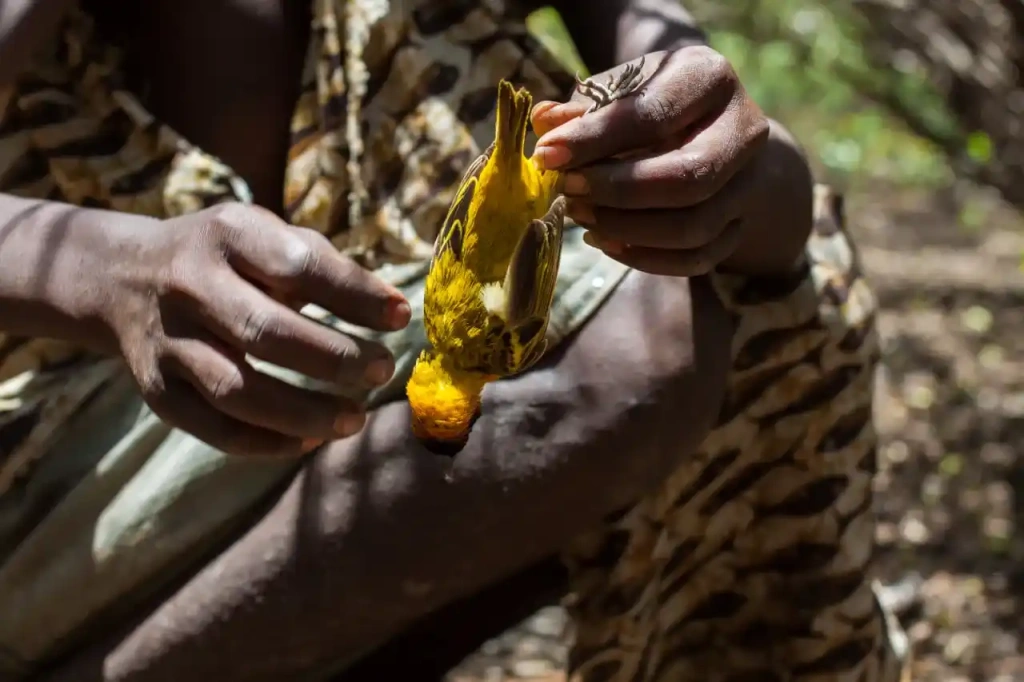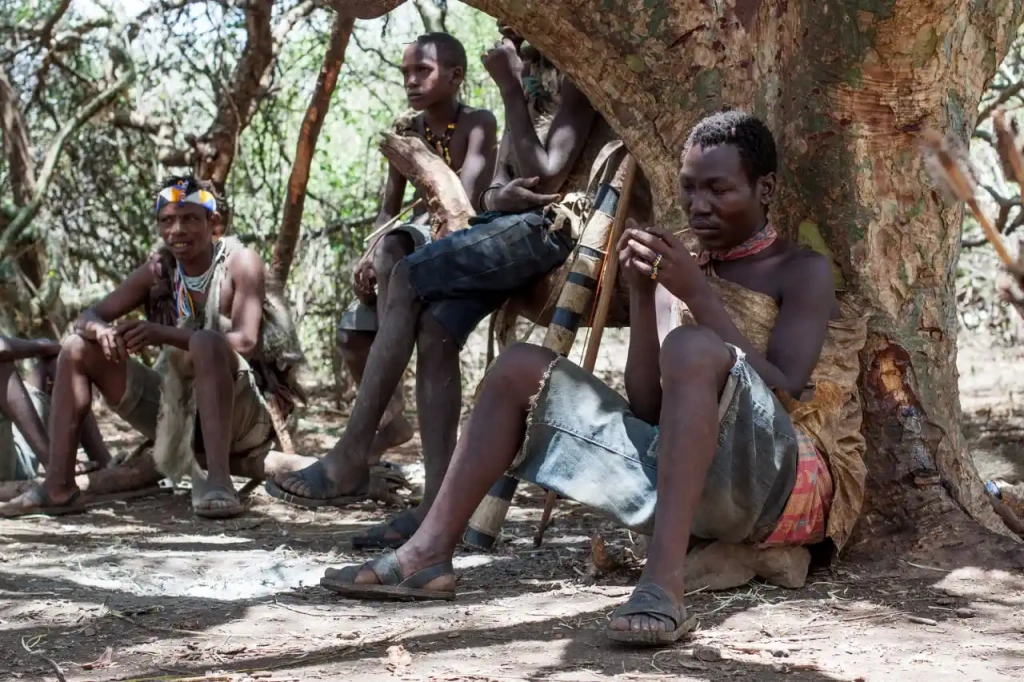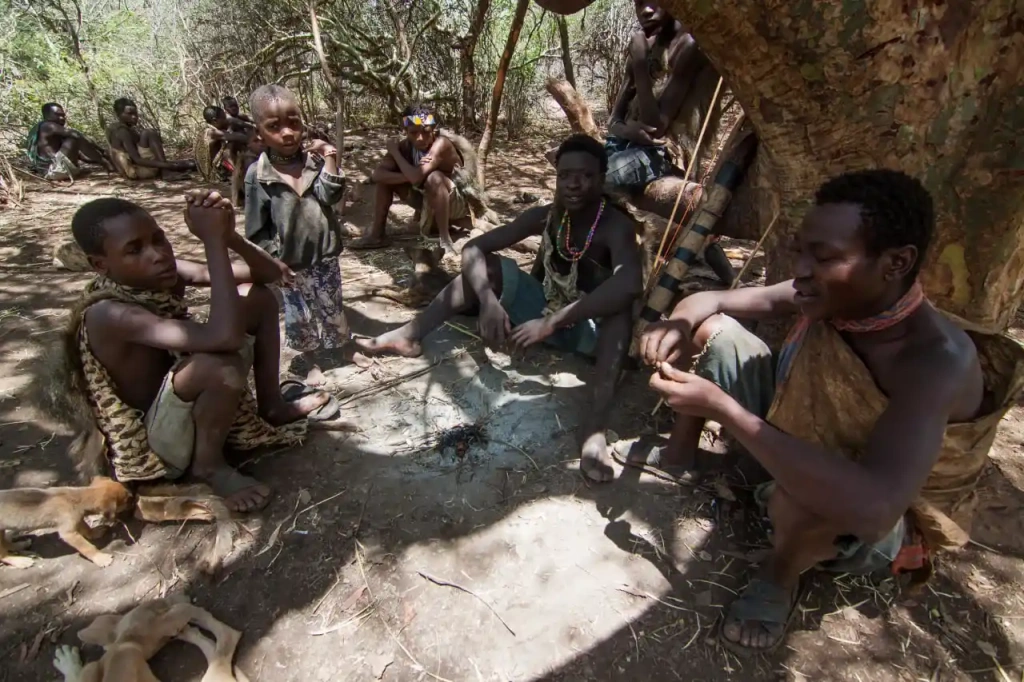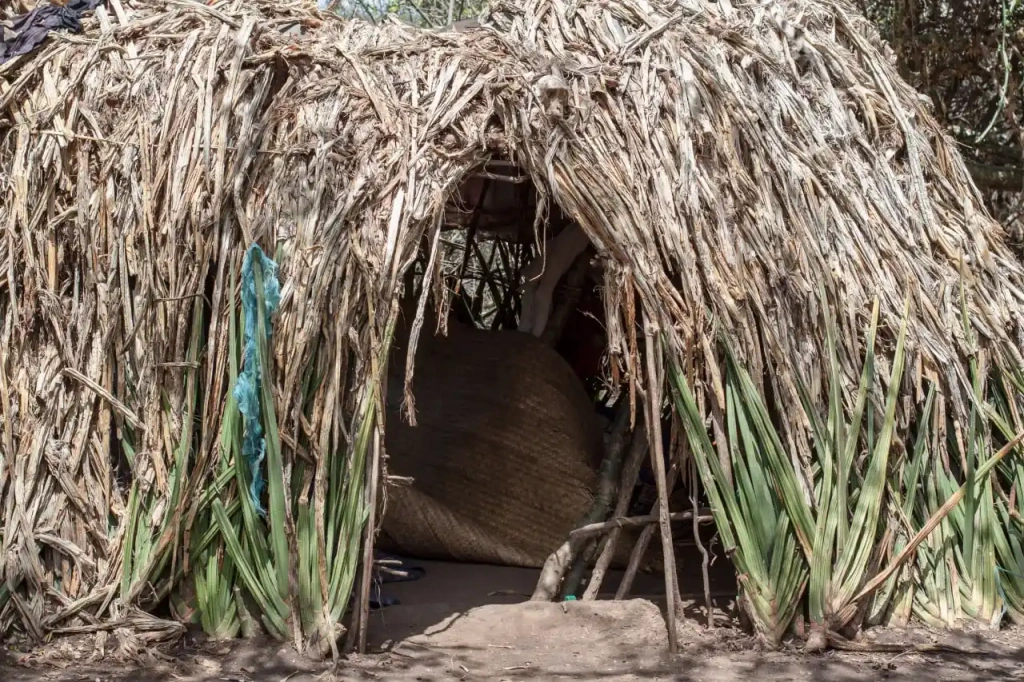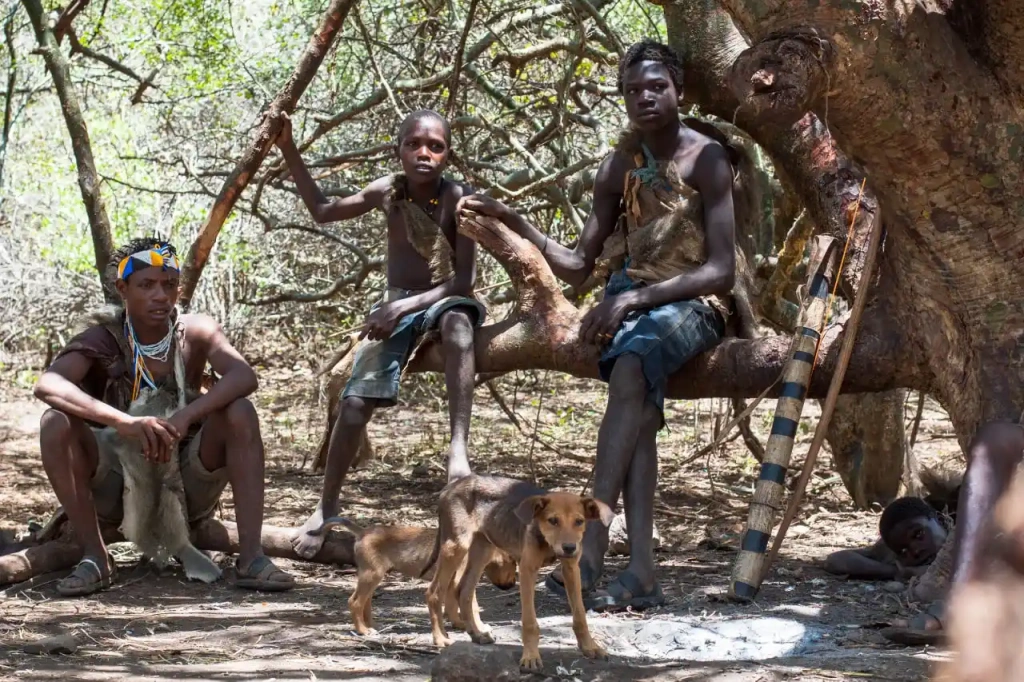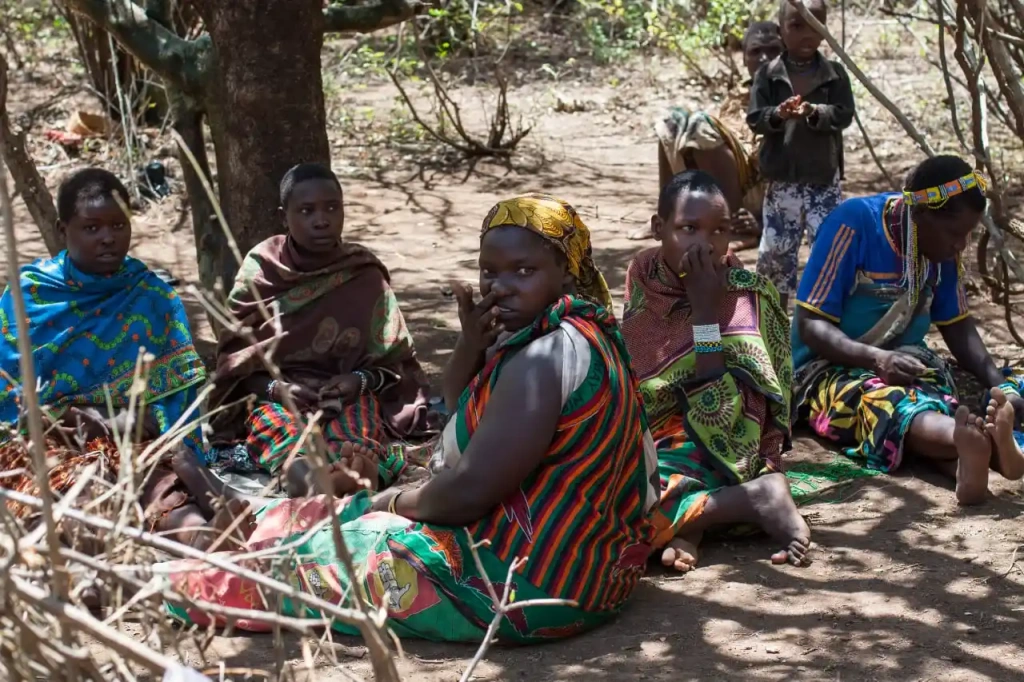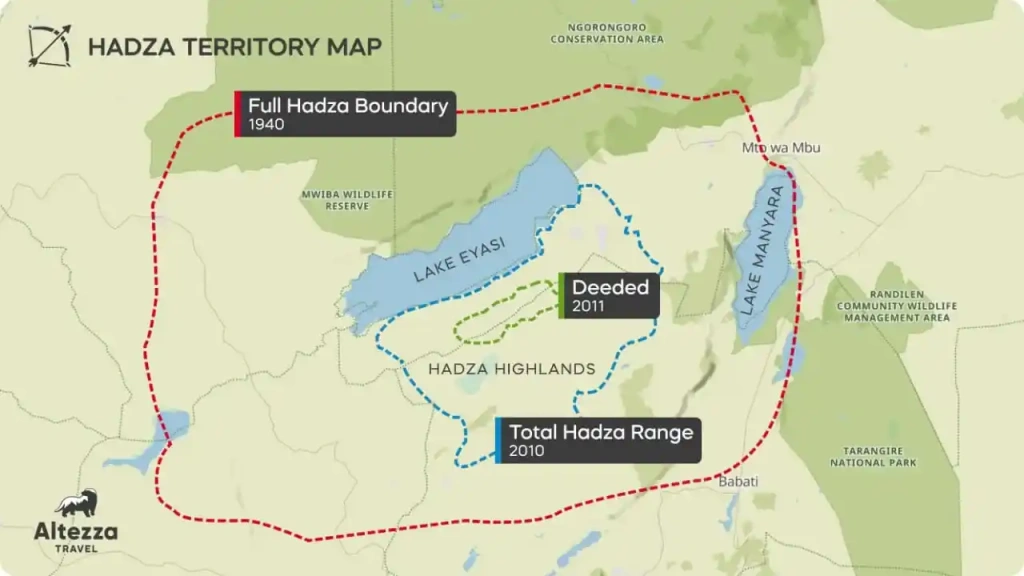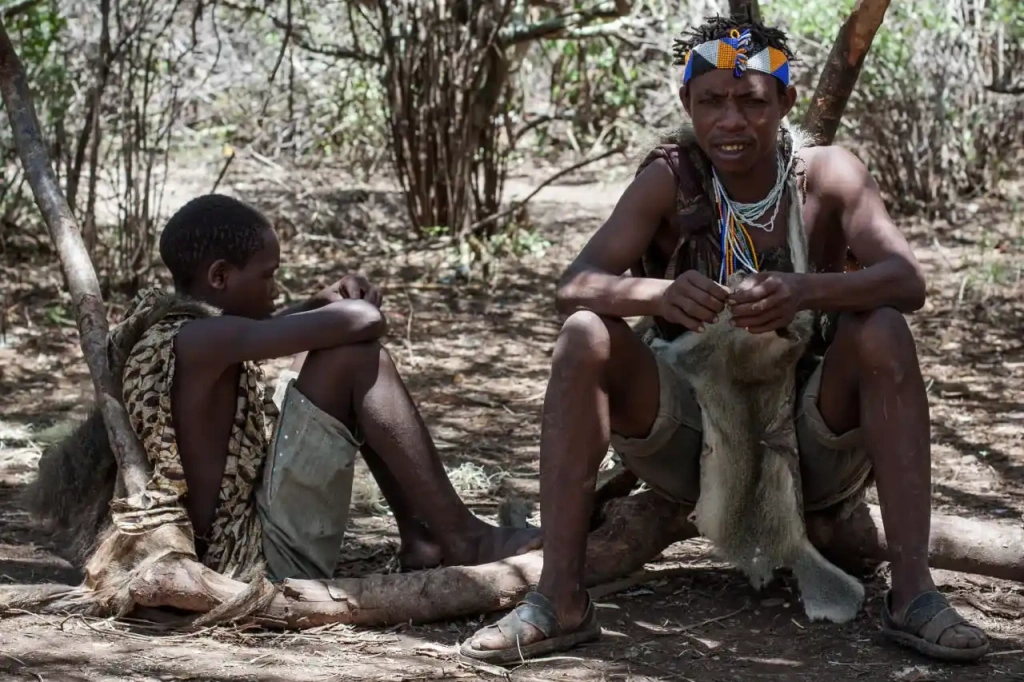Do the Hadza still exist?
Early morning. Four men are running across the African savannah, tinted pink by the rays of dawn. Bright headbands adorn their heads, animal skins, and trophies from past successful hunts, drape their shoulders. Nearby, small long-legged dogs trot alongside. Both men and animals gaze intently around, trying to spot the slightest movement in the bushes.
Suddenly, one of the hunters stops, swiftly draws his bowstring, and releases an arrow. It hits its mark—a small bird resembling a parrot. The hunter secures the catch on his belt and continues running.
Within half an hour, the Hadza men manage to shoot another bird and a couple of squirrels. Clearly, this is not enough to feed the tribe. They need to track down larger prey.
Suddenly, one of the men notices tracks leading to a pile of large boulders. Someone is hiding there. The hunters call their dogs and command them to investigate the boulders. The agile dogs climb into the crevice and erupt into triumphant barks. The prey is found! With shouts and yells, the hunters drive the quarry out of its hiding place and shoot it down. It's a white-tailed mongoose, enough meat for both humans and dogs. Today's hunt can be concluded.
It seems like the described scene took place millennia ago when nomadic hunter-gatherers populated the land. But this is the 21st century, modern Tanzania, the Hadza tribe.
How was the Hadza tribe discovered?
Let’s begin the story of this tribe with the Hadza homeland. The tribe lives in northern Tanzania, near Lake Eyasi. The Hadza were isolated from the rest of the world, thus preserving the way of life and culture of hunter-gatherers.
The first mention of the Hadza tribe dates back to 1897, during the period of the colonial division of Africa by European states. At that time, the territory of modern Tanzania, where the Hadza live, was given to Germany. Therefore, the tribe's way of life was first studied by German researchers: linguist and anthropologist Otto Dempwolff and geographer Erich Obst. The latter lived with the tribe on Hadza land for several weeks and left a detailed description of their way of life.
In the late 1930s, another German researcher, Ludwig Kohl-Larsen, with the support of the German Research Foundation, embarked on an expedition to East Africa. He was a doctor and an amateur anthropologist who studied primitive peoples. He visited the Hadza territory, collected stories from the Hadza folklore and attempted to put forward anthropological theories.
Kohl-Larsen was a member of the Nazi party and supported its ideas. In his research, he tried to prove that all people have the same origin, but native Africans are inferior to Europeans and therefore still lead a primitive, primitive life
After the end of World War II, Ludwig Kohl-Larsen lost his scientific position. The modern scientific community does not recognize his conclusions.
Active research into the life of the tribe continued in the 1960s. Anthropologists, linguists, geneticists, and scientists from other fields visited the Hadza lands and observed the tribe. They studied their way of life, traditions, social structure, and the unique Hadza language.
What is the Hadza tribe known for?
The Hadza do not have permanent camps and lead a nomadic lifestyle.
The way of life of the Hadza hasn't changed much for tens of thousands of years. As of today, the population of the Hadza people is around 1200-1300 individuals. They live in groups of 20-30 people. During long journeys or droughts, they may gather in larger communities of 100-150 people.
Hierarchy in the Hadza society
Within the groups, there is almost no hierarchy in the modern sense of the word. The Hadza respect the elderly members of the tribe and listen to the opinions of the most successful hunter. However, there are no significant status differences. Hadza women and men are equal. In case of a conflict, participants can switch to another group. This, however, makes the groups unstable and often leads to dissolution.
Hadza dwellings
The Hadza are a nomadic hunter-gatherer tribe. During the rainy season, they may settle in caves, but for most of the year, they live in huts. They construct frames from branches and cover them with dry grass. When necessary, the tribe relocates to a new location. For example, if they manage to shoot a large animal like a buffalo or giraffe during a hunt, the Hadza easily move their camp closer to the prey to avoid dragging the heavy carcass.
The main source of food for the tribe is hunting and gathering
The Hadza eat meat, tubers, baobab fruit, berries, and honey. The diet may vary depending on the season. In the dry season, animals gather at a few water sources, allowing hunters to obtain more meat. Common large prey include antelope, monkeys, and bush pig. During the rainy season, the Hadza rely on plant-based food.
The favorite treat of the Hadza - honey
The Hadza have a particular fondness for honey due to its sweet taste and nutritional value. It often constitutes up to 20% of their daily diet. The method the Hadza use to search for wild bees and harvest honey is incredibly fascinating. A bird called the Greater Honeyguide assists tribe members in finding beehives. It locates the hive and leads a person to it with a specific call. When the honey hunter smokes out the bees and collects the honey, the bird gets the wax and other remnants of the raided nest, which it feeds on.
Honey harvesting and hunting are usually done by every Hadza man, while women gather berries, baobab fruit, tubers, turtles, and bird eggs. They venture out in search of food in groups, with at least one adult male accompanying several women.
During hunts, they procure only what they can eat
The Hadza men hunt using homemade bows and arrows. The bowstrings are made from animal tendons, and the arrows are wooden, tipped with stone heads, which are always coated with poison. The poison is extracted from tree bark. If a bow manages to shoot down significant prey, it is adorned with a strip cut from the skin of the killed animal. This way, the "luckiest" bows become the most beautiful.
Hunting within the Hadza tribe is solely conducted by men. They begin training from a young age, initially tracking small animals such as birds, mice, and rabbits alone. When hunting larger prey, they venture out in groups. Some hunters take dogs with them, although this practice is relatively new to the Hadza and has been adopted from other tribes.
Hadza hunters engage in hunting every day. They prepare and consume the caught prey immediately, without returning to the camp. The majority of the meat goes to the hunters, and any leftovers are shared within the tribe. The Hadza do not preserve meat for later consumption, aiming to procure only what they can consume in a day.
With Altezza Travel, you can witness the lifestyle of the Hadza people with your own eyes. We have been organizing expeditions to Lake Eyasi since 2014. During these expeditions, you can learn about the customs of the Hadza and Datoga peoples and observe real primitive hunting. We do not encourage hunting per se but respect the traditions of primitive tribes and strive to preserve their authenticity.
The family structure of the Hadza resembles modern
Like residents of modern cities, the Hadza practice serial monogamy. In other words, they live in pairs and raise children together. However, these pairs can dissolve, after which both the man and the woman find new partners.
Children usually live in the same hut with their parents, although they may also be cared for by grandparents, aunts, and uncles. Children under the age of two to three are not left unattended. Older children may stay in the camp alone while adults are out foraging. From the age of five, children start gathering berries and roots, providing a significant portion of their own diet.
Upon reaching adulthood, young Hadza individuals may choose to continue living with their parents or join another group, as there are no strict rules about these arrangements.
The Hadza language - a unique click language
The Hadza speak a unique isolated language. This means that it does not belong to any known language group. In addition to the vowels and consonants familiar to Europeans, the Hadza language uses clicking and popping sounds. This makes the Hadza language similar to other clicking African languages. However, if you look at the map, it becomes clear that they are mainly spread in southern Africa, while the Hadza people live in the eastern part of the continent, near the Great Rift Valley and the Serengeti Plains. For this and other reasons, linguists do not consider the Hadza language to be related to other African languages.
The Hadza language has no writing system; it exists only in the form of oral tradition and reflects the way of life of the tribe. For example, it has dozens of different words to denote dead animals obtained while hunting. They have also preserved accounts of their history and numerous folklore stories.

Today, about 800 people speak the Hadza language, which is the majority of adult Hadza. The youth are gradually transitioning to Swahili, the more widespread African language. Researchers believe that the Hadza language can be preserved as long as the tribe continues to live traditionally.
How the outside world interferes in the life of the tribe
After the end of World War I, the territory of Tanzania came under British control. The British colonial government tried to convert the Hadza to Christianity, make them live a sedentary life, and engage in agriculture. Britain made two attempts to establish stationary settlements for the Hadza tribe in 1927 and 1939. Both failed: the Hadza abandoned the settlements and returned to their accustomed nomadic way of life.
The Tanzanian government made a third attempt to change the way of life of the Hadza in 1965. The Hadza people were driven into a village settlement under armed escort, where missionaries built a school and hospital. Due to the unfamiliar life in the confined space of the settlement, an epidemic of respiratory infections and measles broke out. Many Hadza died, and the rest soon left the settlement.
Attempts to change the way of life of the Hadza are still ongoing. Some people do become farmers or cattle herders, but the majority choose to continue their traditional hunter-gatherer lifestyle.
Modern Hadza children have the opportunity to go to school. Some families send their children to learn literacy, while others consider it useless. Most tribe members remain in their community, so the ability to hunt, gather honey, and build huts is more important to them than knowing English and Swahili.
How the tribe preserved their Hadza land
A nomadic tribe needs extensive territories to maintain their lifestyle. Previously, the Hadza occupied lands around Lake Eyasi in the central part of the Rift Valley and on the neighboring Serengeti plateau. In recent years, their habitat has been shrinking. The western lands of the Hadza are now a private hunting reserve where hunting is prohibited for the tribe.
Valleys that were previously unsuitable for livestock farming due to the tsetse fly are now occupied by Datoga herders. Berries and roots, which were part of the Hadza diet, disappear on cattle grazing grounds. Large watering holes for agricultural animals dry up small sources of water that the tribe used before.
To protect their habitat, in 2011 representatives of the Hadza tribe claimed the right to the territory based on the Customary Right of Occupancy. Now they officially own 57,000 acres of land in Tanzania.
Is the Hadza Tribe Healthy?
Surprisingly, yes, they appear to be healthier than many city dwellers in several ways. Scientists have noticed that the lifestyle of African hunters and gatherers helps them stay healthier longer. Now they are trying to figure out how to use this to improve the quality of life for modern urban dwellers.
Do the Hadza drink alcohol?
The Hadza warmly welcome tourists. However, active contact with the outside world gradually changes their way of life. Instead of traditional loincloths, tribe members wear shorts and t-shirts exchanged with visitors. They do not value money or most material possessions, but gladly accept other gifts, including alcohol. Since alcoholic beverages were not part of the traditional Hadza diet, this became a significant problem.
Can you live with the Hadza tribe?
Yes, it is possible to live with the Hadza tribe, and many adventurers or scientists have done it. The Hadza tribe also attracts tourists and bloggers. For example, American actor and musician David Choe lived with the tribe for some time to reboot and rid himself of the dependencies of the modern world. He said that at first, he could not fully immerse himself in the primitive life: he slept in a tent and ate modern camping food. But then he decided he wasn't playing by the rules and started hunting, sleeping in a cave, and eating from a common pot. Gradually, he felt much calmer and more peaceful.
Anthropologists continue to actively study the Hadza tribe. For example, anthropologist and human ethologist Marina Butovskaya regularly visits the tribe and lives with the Hadza people for several weeks. She says that the seemingly primitive lifestyle is so attractive that representatives of other African peoples regularly join the Hadza. They quickly integrate into the tribe and call themselves Hadza, although they are not of Hadza origin.
All content on Altezza Travel is created with expert insights and thorough research, in line with our Editorial Policy.

Want to know more about Tanzania adventures?
Get in touch with our team! We've explored all the top destinations across Tanzania. Our Kilimanjaro-based adventure consultants are ready to share tips and help you plan your unforgettable journey.















